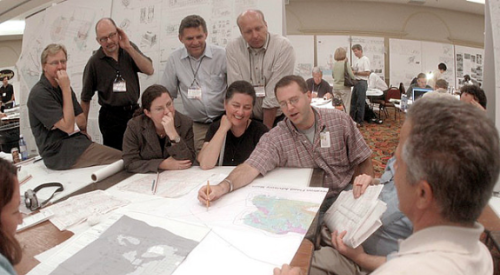| “All the vital signs of traffic and purchases and actual new orders indicate that it’s going to be a very robust market in Florida for 2001.” —Jerry Starkey of Watermark Communities
|
Versatility Sets WCI Apart
Watermark Communities Inc. (WCI) of Bonita Springs, Fla., is different from many of the Giants in two ways: it owns and operates most of the amenities in its communities, and it has been very successful with a market niche most home builders avoid: high-rise residential construction.
WCI’s origins date back to the early 1950s with the Westinghouse Electric real estate division. According to WCI president Jerry Starkey, Westinghouse began developing land on Florida’s east coast in the ’50s, then expanded to the Gulf coast in the early ’70s. “The second root in our corporate tree is Florida Design Communities, which began operation in 1985,” says Starkey. “I joined that firm in 1988, and in 1995, the principals put together a group of institutional investors and purchased the Westinghouse real estate division.” The merger of the two companies resulted in WCI.
Florida Design Communities and Westinghouse each developed amenity-filled, master-planned communities, Starkey says. The difference is that Florida Design also built homes, while Westinghouse developed the land and sold lots to other builders. “Our strategy in purchasing Westinghouse was to become the principal home builder of all the lots we develop in our communities, and we’ve successfully done that over the past several years,” he says. “WCI owns approximately 17,000 acres in Florida, enough to build about 29,000 units.”
This year, WCI ranks 31st in the Giant 400 with housing revenues of $614.6 million and 1874 closings. That’s compared to $470.6 million and 1677 closings last year. Not only did the company exceed 1999 sales of single-family and low-rise multifamily homes, it sold more than 300 luxury high-rise condominiums.
“About half the homes that we built are traditional single-family homes; the other half are multifamily,” says Starkey. “Our average sales price is close to $400,000. We have homes that are priced in the low $100,000s and homes that are priced in the $8 million range, so we cover a broad spectrum.” The buyers include move-ups, retirees and vacation/second home purchasers.
He attributes WCI’s success in the high-rise market to the old real estate axiom of “location, location, location.” The company owns about 30 planned communities in Florida, all located on the Atlantic Ocean, the Gulf of Mexico or one of the intracoastal waterways. Ranging from several hundred to several thousand acres, the communities feature WCI-owned and operated golf courses, marinas, restaurants and other facilities, which are significant profit centers.
“In creating these large communities, we are able to create sites appropriate for luxury high-rise,” says Starkey. In addition, the ancillary businesses owned by WCI, which include mortgage, title, property management and real estate brokerage subsidiaries, allow the company to create a “one-stop-shopping” experience for home buyers, he says.
In-house architects design all single-family and low-rise attached housing. Land planning is also done internally. The high-rise condominium towers are designed by outside architects who have expertise with tall buildings. “High-rise residential is a completely different business,” he says. “It’s more of a commercial construction process than residential.”
Starkey says that because WCI develops, builds and operates the amenities as well as the housing, it can be more market-driven. “We actually conceive and design products to maximize the lifestyle around the amenities, as opposed to just building traditional homes. That’s especially the case in some of the lower density multifamily products. We try to be innovators of design.”
Lately, WCI has been zeroing in on three of the most affluent markets in Florida: Sarasota, Venice and Palm Beach. These are the best locations in the state for wealthy retirees and pre-retirees, he says. “We develop specific product for each market that we enter.”
The company started the new year aware of a potential economic slowdown but, says Starkey, “All the vital signs of traffic and purchases and actual new orders indicate that it’s going to be a very robust market in Florida for 2001. We’re seeing significant growth over 2000, notwithstanding the headlines relative to the nation as a whole.”
One of WCI’s goals, he says, is to continue to grow at 20% to 25% a year. Company executives are also investigating the possibility of an IPO.
Movers and Shakers: Emerald Builders
Movers and Shakers: Christopher Homes
Movers and Shakers: Lennar Corp.
Movers and Shakers: Village Homes
Movers and Shakers: Sunrise Colony Co.
Movers and Shakers: Orleans Homebuilders
Movers and Shakers: Habitat for Humanity












